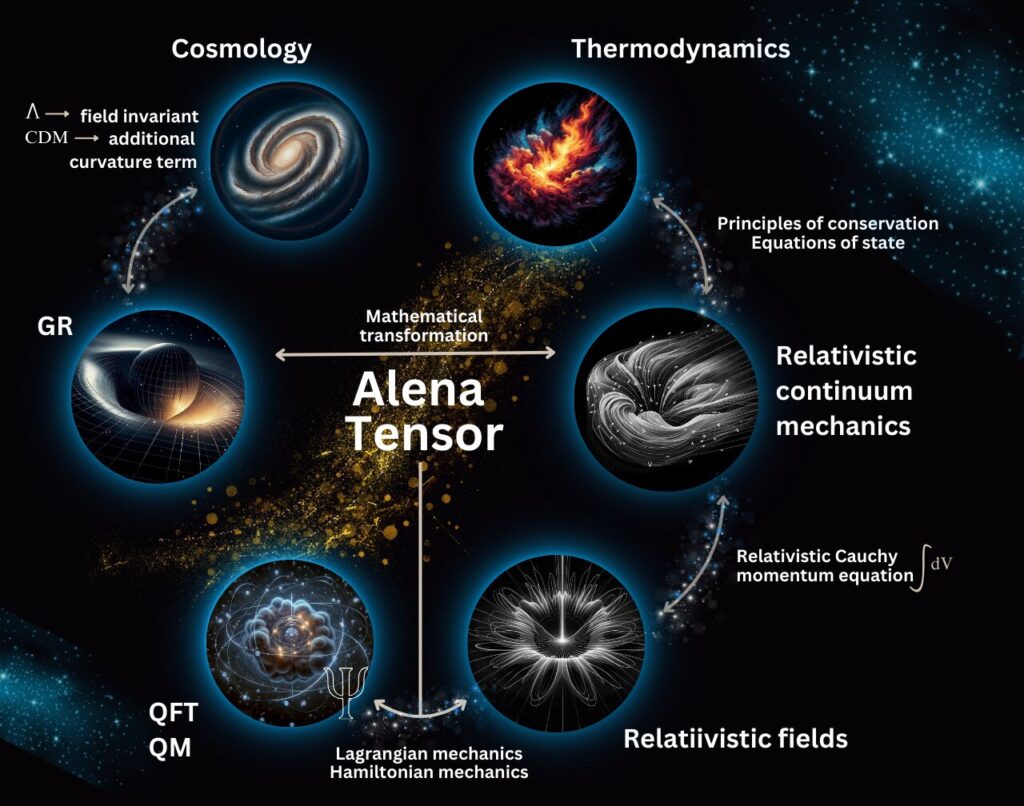Physicists have long sought a unified framework that can reconcile general relativity, which describes gravity and the structure of spacetime on cosmological scales, with quantum mechanics, the theory governing particles and forces at the smallest scales. These two pillars of modern physics remain fundamentally incompatible in extreme conditions such as black holes or the early universe. However, a new development may offer a path toward unification: the introduction of the Alena Tensor.
Toward Unification: The Role of the Alena Tensor
In January 2025, a collaborative team of theoretical physicists led by Dr. Sarah El-Baz of the Perimeter Institute and Dr. Lorenzo Failla of the Max Planck Institute for Gravitational Physics introduced the Alena Tensor—a novel mathematical structure designed to function across both relativistic and quantum domains. Their work, published in Physical Review Letters, proposes the tensor as a unifying entity capable of describing curvature in both classical and quantum contexts.
Unlike traditional tensors in general relativity, which relate mass-energy to the geometry of spacetime, the Alena Tensor incorporates quantum field terms that respect uncertainty principles and superposition. This dual compatibility is key to its potential role in bridging quantum field theory and the Einstein field equations.
Key Properties and Theoretical Significance
The Alena Tensor is constructed to be covariant under both general coordinate transformations and local gauge transformations, a feature necessary for consistency in both general relativity and quantum field theory. The team demonstrated that under classical limits, it reduces to the Einstein tensor, while under quantum-dominant regimes, it maps onto the stress-energy behavior expected from quantum fields.
Early simulations using the tensor have shown promising results in modeling spacetime behavior near singularities—regions where traditional physics breaks down. For example, in modeling near-black-hole interiors, the Alena Tensor has allowed for stable calculations that suggest smooth transitions instead of mathematical infinities.

Implications for Theoretical Physics
If further verified, the Alena Tensor could become a foundational component of a quantum gravity theory. Its mathematical flexibility enables potential integration with existing frameworks such as loop quantum gravity and string theory. It may also offer a way to re-express the path integral formulation of quantum mechanics in curved spacetime backgrounds.
This would not only clarify physical behavior in extreme environments but also assist in refining cosmological models of the early universe, where both quantum and relativistic effects play a critical role.
Caution and Next Steps
While the theoretical formulation is rigorous, the Alena Tensor remains a proposed solution that requires extensive peer review, replication, and practical testing through high-energy physics simulations. Several research groups, including teams at MIT and the University of Tokyo, have begun independent assessments of the tensor’s compatibility with existing quantum field models and its predictive power in novel scenarios.
Experimental verification remains out of reach for now, given the energy scales required to probe such fundamental physics directly. However, indirect evidence—such as refined gravitational wave patterns or quantum vacuum fluctuations—may eventually provide testable predictions.
Conclusion
The development of the Alena Tensor marks a potentially significant advance in the pursuit of a unified physical theory. While it does not yet constitute a complete solution, its introduction provides a mathematically consistent and theoretically promising bridge between the quantum and relativistic realms. The coming years will determine whether this structure can serve as a viable foundation for the long-sought theory of quantum gravity.





